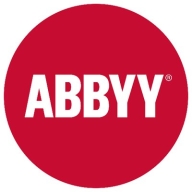


UiPath and ABBYY Vantage are both leaders in their respective fields of automation and document processing. UiPath seems to have an edge due to its strong user community, ease of use, and comprehensive automation capabilities that go beyond basic RPA functions. ABBYY Vantage, while highly regarded for its robust OCR capabilities and multilingual support, doesn't quite match UiPath's flexibility and scalability across various platforms and processes.
Features: UiPath offers a powerful combination of end-to-end automation, AI integration, and a drag-and-drop interface, which simplifies automation for users of all skill levels. It is well-supported by an extensive community and comprehensive training resources through UiPath Academy. Meanwhile, ABBYY Vantage excels in OCR accuracy and supports over 100 languages, coupled with pre-trained AI models that enhance document processing and data extraction.
Room for Improvement: UiPath could focus on advancing its AI capabilities to handle more complex tasks and better manage system updates to prevent unannounced changes. Improvements in integration with third-party tools would enhance its utility. ABBYY Vantage might benefit from expanding its model training for newer document scenarios, as well as offering simpler setup processes for non-technical users.
Ease of Deployment and Customer Service: UiPath boasts a straightforward deployment process with substantial resources available for users, including community support and UiPath Academy. ABBYY Vantage provides flexible deployment options, both in the cloud and on-premises, although initial setup can be intricate. Its customer service is reliable, assisting users efficiently despite some setup challenges.
Pricing and ROI: UiPath offers a flexible and competitive pricing model suitable for businesses of all sizes, with notable ROI achieved through automation savings and operational efficiency. ABBYY Vantage provides significant value with its document processing accuracy and efficiency, though its initial setup costs might be higher for smaller organizations. Both platforms contribute significantly to cost savings and productivity enhancements.
Fortra's Automate has effectively replaced the workload of an entire employee, saving us significant time and money.
It has reduced our expenditures in terms of purchasing more products and employing more technicians.
On a scale from one to ten, I would rate the ROI as nine.
It has saved about 20% to 30% of costs.
We have seen a 100% return on investment.
UiPath has reduced human error and saved employee time.
They don't always understand the processes I'm trying to implement.
I would rate the technical support as a nine out of ten because it is quite fast and courteous.
They are very responsive and have been able to resolve any issues I have encountered.
They were very helpful, addressing the issue in three hours.
Even though they are external, I can ping them on Slack and I get a response right away, so they really make it very accessible to be in touch.
He works through whatever unique internal environment scenarios we have to overcome to make sure that it's doing exactly what we need, even though we're constantly having new security measures to implement on top of it.
The scalability of Automate also scores a ten out of ten.
It is easy to increase one bot or one studio without needing to buy another orchestrator, which can be quite expensive.
Automate is stable for my needs and is highly scalable, allowing the same workflow to serve numerous tasks effectively.
The solution is capable of scaling with just a few clicks.
The scalability of the UiPath Platform rates a ten out of ten.
From a technical standpoint, it's essential to make the right technical decisions and design a scalable solution.
The stability of the solution is a ten out of ten.
For stability on a scale from one to ten, I would give it a solid nine.
It has very robust features, and it is not prone to instability.
Overall, there was only one instance of downtime in four years, which did not create any significant impact.
I have not experienced any downtime, crashes, or performance issues.
Over six years, we have created zero support cases with UiPath.
This is a significant concern, especially with critical workloads where visibility into errors is essential.
My major recommendation would be for easier upgrade paths between major versions.
When new employees join our company, we created automation so they receive AWS credentials and all their AWS access and cloud access.
Simplifying workflow creation by chatting with the system rather than dragging and dropping elements would make the platform more user-friendly, especially for non-technical users.
Based on our use cases, handwritten recognition for Arabic is not supported.
The vendor invoice processing skill of ABBYY Vantage could be enhanced by adding more fields that are commonly used across multiple invoices.
Adding more AI could help in small tasks that require intelligence or machine learning, leading to the next stage of automation.
If the UI changes or a label is changed, sometimes the whole flow breaks.
Regarding additional functionality for UiPath, I believe that additional features will only come into play when you start talking to the customers, accept feedback, and work on it.
Competitors are often more expensive than Automate.
It offered what we wanted at a good, competitive price.
It does a lot but also costs a lot.
There are other solutions available at a lower cost.
I would say the pricing is in the middle.
Most of the UiPath products are priced higher than competitors.
The cost can be a barrier in Hungary, making it difficult for me to persuade others to invest, especially when unattended robots come at a significant price point.
When compared to competition, such as Microsoft's Power Automate platform or IBM Cloud Pak, UiPath is expensive.
Automate's non-reliance on additional orchestrators makes it quite cost-effective.
In my opinion, the best feature Automate offers is the scheduling.
Automate's compatibility with existing IT infrastructure has impacted our business operations positively by providing smooth integration with other software that we use, such as Gmail, Jira, and Microsoft 365 apps, which gives us a unified platform instead of having to keep switching from one software to another, saving a lot of time and streamlining the whole workflows.
The AI capabilities facilitate querying and document classification, and they have good post-processing capabilities.
ABBYY has a very good OCR in both Arabic and English.
ABBYY Vantage has AI features that learn automatically about invoice fields and related functionality.
The tool has a noticeable ROI, and the investment is worth every penny as it reduces tedious tasks and improves scalability.
Our use of automation sped up the process of getting paid from insurance companies, saving us substantial amounts of money.
Whenever they release a product, they also release a course in UiPath Academy. So, you can get familiarized with the product and understand the new capabilities.
| Product | Market Share (%) |
|---|---|
| UiPath Platform | 16.3% |
| Automate | 2.3% |
| ABBYY Vantage | 1.3% |
| Other | 80.1% |




| Company Size | Count |
|---|---|
| Small Business | 23 |
| Midsize Enterprise | 8 |
| Large Enterprise | 6 |
| Company Size | Count |
|---|---|
| Small Business | 13 |
| Midsize Enterprise | 10 |
| Large Enterprise | 29 |
| Company Size | Count |
|---|---|
| Small Business | 240 |
| Midsize Enterprise | 144 |
| Large Enterprise | 661 |
Automate offers a user-friendly solution with a drag-and-drop interface for efficient task automation and integration with major platforms like SAP and Azure, making it ideal for quick deployment with minimal coding and training.
Automate provides powerful features for businesses seeking efficient automation, offering compatibility with databases, email integration, and cloud platforms. Its simple interface supports both beginners and experienced users, simplifying tasks like invoice processing, HR automation, and data transformation. Cost-effective pricing and flexible licensing enhance its appeal while integration capabilities and scheduling tools ensure smooth workflow automation.
What are Automate's Key Features?In industries such as healthcare, banking, and logistics, Automate is used for tasks like invoice payment automation, data transformation, and task automation. This leads to streamlined processes and reduced manual workload, illustrating its value in enhancing operational efficiency through diversified workflows.
ABBYY Vantage is an industry-leading low-code Intelligent Document Processing (IDP) platform that uses state-of-the-art AI and machine learning to automate document-centric business processes.
Businesses use Vantage to efficiently and reliably automate the manual, error-prone tasks of capturing and extracting data from documents, so they can immediately deliver accurate, process-ready content into their business systems—RPA, BPM, ERP, etc., and improve decision-making and insights. Pre-trained AI extraction models help organizations get a head start in efficiently automating document processing across various use cases and departments with 90% accuracy right from the get-go. Additionally, ABBYY's best-in-class OCR technology enables organizations to securely integrate large language models (LLMs) and generative AI through Retrieval-augmented Generation (RAG).
By utilizing ABBYY IDP organizations achieve significant efficiency gains, cost reduction and operational excellence.
Schedule your Vantage demo today
ABBYY Vantage Capabilities
How does ABBYY Intelligent Document Processing work?
Main use cases
Business processes that can be automated with ABBYY IDP
You can use Vantage to digitize, automate, and process almost any type of document. It can be especially effective for a number of use cases, including:
Some examples of documents ABBYY can process include:
Visit the ABBYY Marketplace to explore all available pre-trained models from ABBYY and the ABBYY partner network.
ABBYY Vantage Benefits
UiPath Platform is appreciated for its user-friendly interface and extensive automation capabilities, offering seamless integration with diverse applications. Its intuitive drag-and-drop functionality enables users to design efficient workflows with minimal technical expertise.
UiPath Platform delivers a robust set of features that enhance automation and productivity. With components like Orchestrator, task management is optimized, facilitating better scalability. Users benefit from advanced AI and document understanding tools, boosting data handling accuracy and reducing errors. Despite its strengths, UiPath faces challenges with upgrading processes, AI enhancements, and user documentation. Integration and selector sensitivity issues, along with support and licensing complexities, highlight areas for potential improvement. Users request smoother deployment, error handling, and migration processes. Enhanced support for RHEL/Ubuntu, LINQ, and Lambda and improved real-time insights, automation recording, and scheduling are desired. Streamlining the experience for non-technical users with simplified workflows remains a priority.
What are the key features of UiPath Platform?UiPath Platform is widely implemented across sectors such as finance, healthcare, insurance, HR, IT, and supply chain to automate repetitive business tasks. Common uses include automating data entry, invoice processing, document management, report generation, and customer service operations. Organizations value the platform's ability to integrate seamlessly with systems like SAP, CRM, and Oracle, allowing for enhanced efficiency and accuracy in processing both structured and unstructured data.
We monitor all Robotic Process Automation (RPA) reviews to prevent fraudulent reviews and keep review quality high. We do not post reviews by company employees or direct competitors. We validate each review for authenticity via cross-reference with LinkedIn, and personal follow-up with the reviewer when necessary.